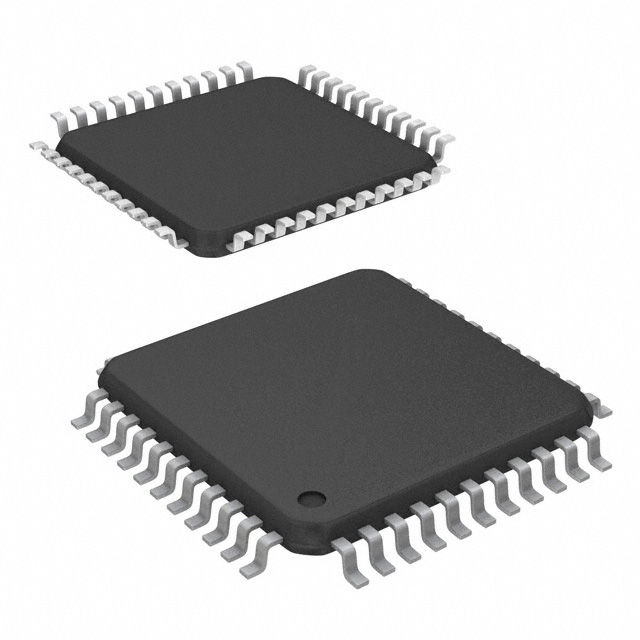ATMEGA164P-20AU
Introduction
The ATMEGA164P-20AU is a microcontroller belonging to the ATmega series, which is developed by Atmel Corporation. This microcontroller is widely used in various electronic applications due to its versatile features and capabilities.
Basic Information Overview
- Category: Microcontroller
- Use: Embedded systems, industrial control, consumer electronics
- Characteristics: Low power consumption, high performance, versatile I/O capabilities
- Package: TQFP (Thin Quad Flat Package)
- Essence: The ATMEGA164P-20AU is a high-performance, low-power 8-bit AVR microcontroller.
- Packaging/Quantity: Available in tape and reel packaging with varying quantities.
Specifications
- Architecture: 8-bit AVR
- Flash Memory: 16 KB
- SRAM: 1 KB
- EEPROM: 512 Bytes
- Operating Voltage: 1.8V to 5.5V
- Max CPU Speed: 20 MHz
- I/O Pins: 32
- Communication Interfaces: UART, SPI, I2C
- Analog Inputs: 8-channel 10-bit ADC
Detailed Pin Configuration
The ATMEGA164P-20AU features a total of 44 pins, including digital I/O, analog inputs, power supply, and communication interface pins. The pinout configuration provides flexibility for interfacing with external components and peripherals.
Functional Features
- High-Performance CPU: The microcontroller operates at a maximum speed of 20 MHz, providing efficient processing capabilities.
- Versatile I/O Capabilities: With 32 I/O pins and multiple communication interfaces, it can interface with a wide range of external devices.
- Low Power Consumption: The microcontroller is designed for low power operation, making it suitable for battery-powered applications.
- On-Chip Peripherals: It includes features such as timers, PWM outputs, and analog-to-digital converters, enhancing its functionality.
Advantages and Disadvantages
Advantages
- Versatile I/O capabilities
- Low power consumption
- Rich set of on-chip peripherals
- Wide operating voltage range
Disadvantages
- Limited program memory compared to higher-end microcontrollers
- Limited RAM capacity for data storage
Working Principles
The ATMEGA164P-20AU operates based on the Harvard architecture, featuring separate program and data memories. It executes instructions fetched from the Flash memory, utilizing its on-chip peripherals and I/O capabilities to interact with external components and perform various tasks.
Detailed Application Field Plans
The ATMEGA164P-20AU finds applications in diverse fields, including: - Embedded Systems: Used in embedded control systems for industrial automation and monitoring. - Consumer Electronics: Employed in smart home devices, IoT products, and portable gadgets. - Automotive Electronics: Integrated into automotive control modules and infotainment systems.
Detailed and Complete Alternative Models
- ATMEGA324P-20AU: Offers increased program memory and I/O capabilities
- ATMEGA644P-20AU: Provides higher program memory and additional features for more complex applications
- ATMEGA1284P-20AU: Offers expanded memory and enhanced peripheral options for demanding applications
In conclusion, the ATMEGA164P-20AU microcontroller serves as a versatile and efficient solution for a wide range of electronic applications, offering a balance of performance, power efficiency, and I/O capabilities.
Word Count: 511
Lista 10 Vanliga frågor och svar relaterade till tillämpningen av ATMEGA164P-20AU i tekniska lösningar
What is the ATMEGA164P-20AU microcontroller?
- The ATMEGA164P-20AU is a high-performance, low-power 8-bit AVR microcontroller based on the AVR enhanced RISC architecture.
What are the key features of ATMEGA164P-20AU?
- Some key features include 16KB of in-system self-programmable flash memory, 1KB EEPROM, 1KB SRAM, 32 general-purpose I/O lines, and more.
How can I program the ATMEGA164P-20AU?
- The ATMEGA164P-20AU can be programmed using various development tools such as Atmel Studio, AVRDUDE, or other compatible programming software and hardware.
What are the typical applications of ATMEGA164P-20AU?
- It is commonly used in applications such as industrial control systems, consumer electronics, automotive systems, and various embedded control systems.
What is the operating voltage range of ATMEGA164P-20AU?
- The operating voltage range is from 1.8V to 5.5V, making it suitable for a wide range of applications.
Does ATMEGA164P-20AU have built-in communication interfaces?
- Yes, it has USART, SPI, and I2C interfaces for serial communication with external devices.
Can ATMEGA164P-20AU be used for real-time applications?
- Yes, it can be used for real-time applications due to its high-performance CPU and timer/counters.
What are the available development boards for ATMEGA164P-20AU?
- There are various development boards available from Atmel and third-party manufacturers that support ATMEGA164P-20AU for rapid prototyping and development.
Is there a community or forum for ATMEGA164P-20AU developers?
- Yes, there are online communities and forums where developers can discuss and seek help related to ATMEGA164P-20AU-based projects.
What are the power-saving features of ATMEGA164P-20AU?
- It includes multiple sleep modes, power reduction registers, and an advanced power-on reset circuit for efficient power management in battery-powered applications.


